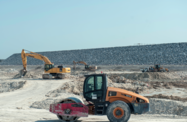With Qatar’s state budget now moving into deficit for the first time in 15 years, clearly a new paradigm for construction project financing is now beginning.
This new pattern will likely continue to be the blueprint for some time, too, as many analysts believe oil and gas prices are unlikely to dramatically turn around soon – further eroding government revenues – while major infrastructure projects will continue to call on the state’s resources in the lead up to the 2022 World Cup.
In combination, these factors will mean that deficit budgets are likely to be around for some time to come.
This places extra burdens on alternate sources of financing, with Qatar’s domestic banking sector likely to meet many of the construction sector’s continuing needs.
Another source of financing is the capital markets, with bond issues also likely to see a spike in the year to come.
At the same time, too, the willingness of the government to continue financing major projects, despite their budget deficit implications, also shows the level of commitment that there is in Doha to infrastructure roll out. Cutbacks are thus likely to focus on streamlining existing projects and eliminating inefficiencies – moves that will likely be all to the good, going forward.
Budget Crunch
The announcement of a 2016 budget deficit had long been heralded, with the government revealing a projected 4.9% of GDP budget shortfall in June 2015. In mid-December, this was given greater definition, at QR46.5bn ($12.8bn), with the shortfall comprising the difference between QR156bn ($42.8bn) in forecast revenues and QR202.5bn ($55.6bn) in forecast expenditure.
The shortfall in revenue – the previous budget had projected revenue of QR226bn ($62bn) – was all about falling oil and gas prices. The average price of Qatari crude fell 45.6% between December 2014 and December 2015, a figure reflected in a $1.7bn balance of payments deficit in 3Q15, as the value of hydrocarbon exports shrank.
Thus, the government announced a budget deficit for the year ahead, as it was also keen to make sure that there would be no let up in government expenditure in areas such as infrastructure, health, education and transport. Indeed, major infrastructure expenditure of QR50.6bn ($13.8bn) was still in the budget, with railways, roadways, electricity, water and sewerage works extensions and the new Hamad Port mentioned specifically for continued financing.
The second point emphasised in the new budget announcement was that the government would not be looking to finance shortfalls by dipping into its extensive reserves. Instead, it would be seeking to tap local and international debt markets to fill the gaps.
Therefore, the budget deficit will most likely result in further government debt issuances.
The deficit also raises questions over the ability of the state’s banks to take on an even bigger slice of Qatar’s project financing, as the government refrains from taking on new initiatives. The good news is that due to a number of factors, Qatar’s lenders are in excellent shape to do this.
Firstly, this is because of the large share held in Qatar’s banks by the Qatar Investment Authority (QIA). This government backing means that the banks enjoy systemic support when issuing new paper and extending new loans.
Second, there is the demographic factor. Qatar has a growing population – 2.42m in December 2015, up 8.3% year-on-year – meaning increasing bank deposits, particularly from individuals and private corporations. This has, indeed, been balancing out the negative effects of a decline in public sector deposits as a result of declining government revenues and cutbacks. QNB figures show public sector deposits falling 9.9% between October and November 2015, for example, while private sector deposits rose 11.9%.
This means that the banks are riding out public sector cutbacks better than others, maintaining a strong position from which to extend credit. The QNB figures also show asset growth of 12.3% between the same two months, with growth in project financing and credit extended to the general population the two factors behind this.
Thirdly, the country’s banks are also having to shape up for Basel III – a new regulatory regime that seeks to produce an even more robust sector via still-greater capital buffers. This will translate into banks issuing more Basel III-complaint securities in 2016 to meet the higher capital requirements. Both eurobond and sukuk issuances are thus expected to spike substantially.
Basel III also means the banking sector will be healthier in many other ways too, enabling project financing to enjoy a more secure environment. This may also mean riskier, less credit-worthy projects being filtered out, but this will be all to the good for the banks, as well as for the construction sector itself.
This also highlights one other potential implication of the new paradigm. Projects will have another set of people to convince, other than the government, if credit is to be extended. Bankability will be key, with well-structured and thought-through projects likely to receive support, while those of a more risky nature may struggle. Qatar will likely be the healthier for this, however, with a stronger role for private sector financing in the longer term likely an important benefit arising from the state’s current deficit challenges.
--This original article from OBG originally appeared in Qatar's Construction News, Yearbook 2016 issue.

